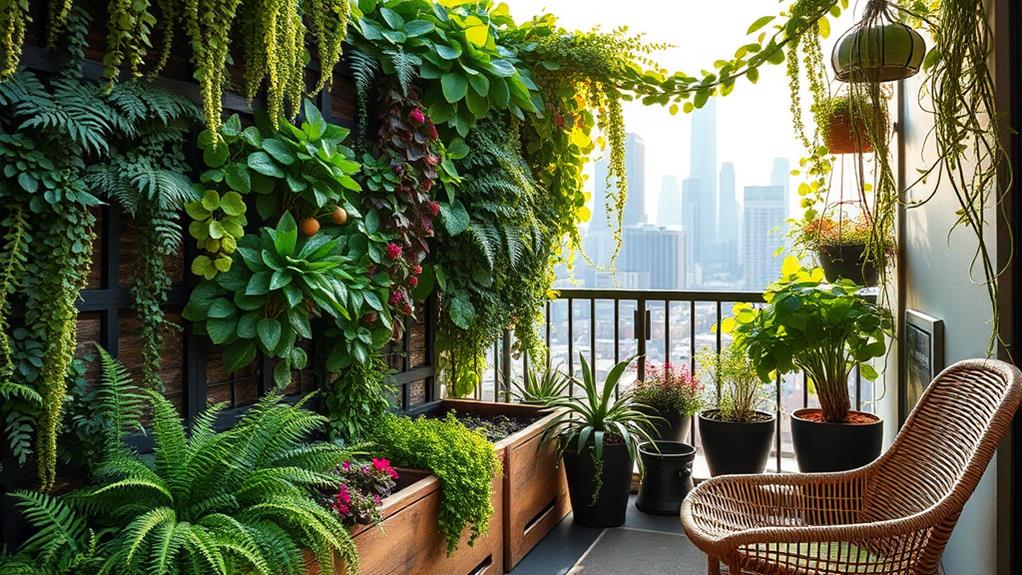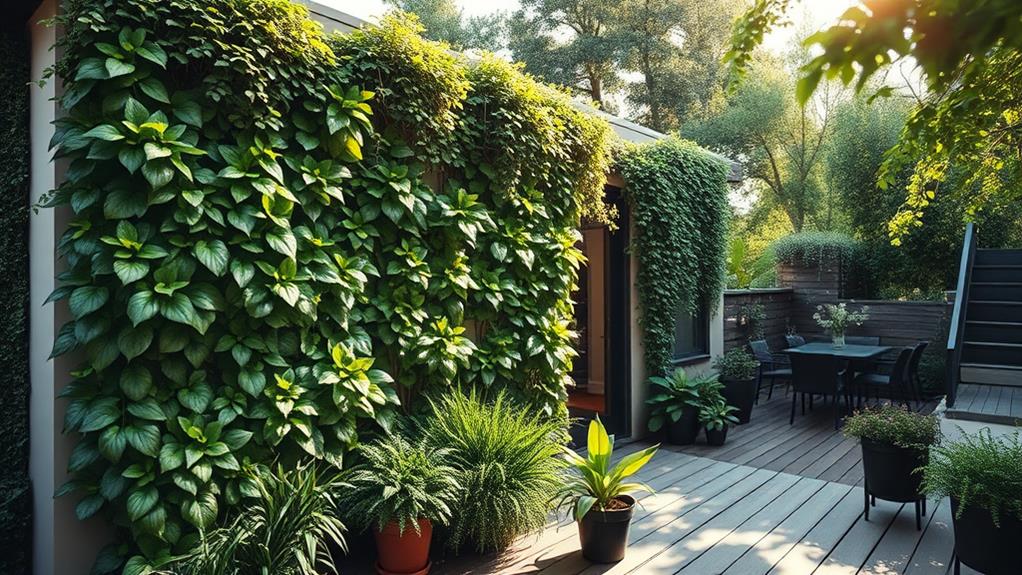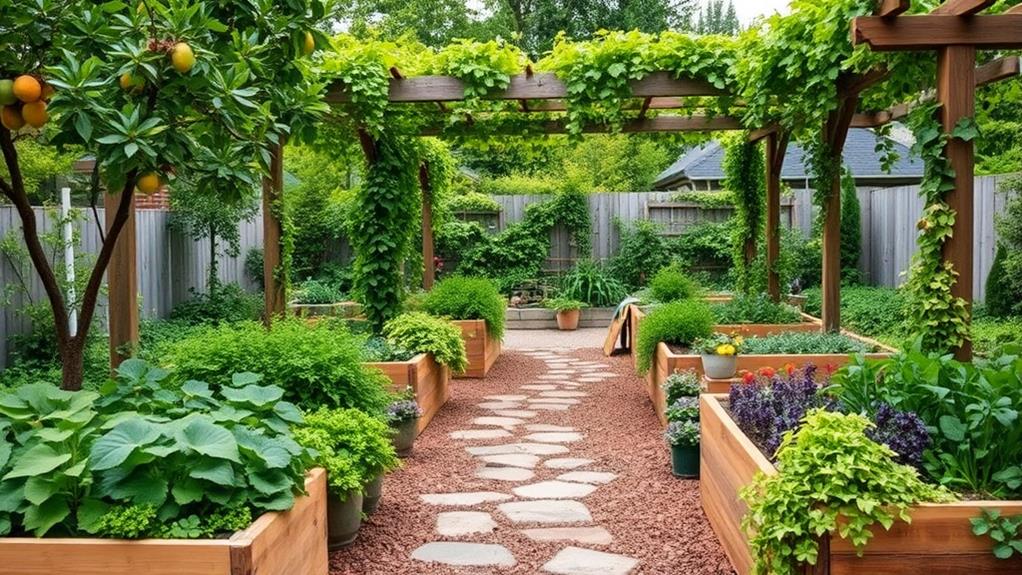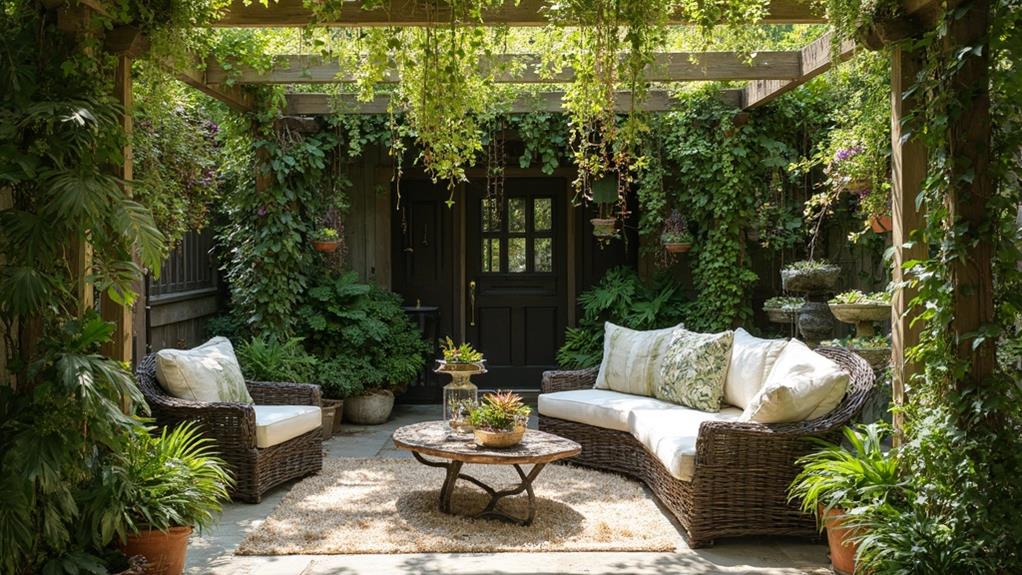Plant lovers can transform outdoor spaces through innovative renovations that seamlessly integrate greenery. Vertical gardens maximize space utilization, while custom planters and built-in solutions offer tailored options. Living walls and green screens create striking visual impacts and environmental benefits. Water features with aquatic plants add refreshing elements to landscapes. Edible landscaping and herb gardens combine ornamental appeal with practical food production. For year-round gardening, climate-controlled greenhouses and sunrooms extend growing seasons and create versatile living spaces. These approaches not only enhance aesthetics but also contribute to biodiversity and sustainable living. Exploring these options can lead to a truly immersive plant-centric outdoor experience.
Vertical Gardens for Space Maximization

Vertical gardens offer an innovative solution for maximizing green space in limited areas during renovations. These living walls transform unused vertical surfaces into lush, verdant displays, adding both aesthetic appeal and environmental benefits to outdoor spaces. By utilizing walls, fences, or specially designed structures, vertical gardens allow homeowners to incorporate a diverse range of plants without sacrificing valuable floor space.
When planning a vertical garden, consider factors such as sunlight exposure, irrigation systems, and plant selection. Choose plants that thrive in vertical environments, such as ferns, succulents, or trailing vines. Modular systems with individual planting pockets or hydroponic setups can simplify installation and maintenance. Proper support structures and waterproofing are essential to protect the underlying wall from moisture damage.
Vertical gardens offer numerous advantages beyond space-saving. They can act as natural insulation, reducing energy costs and improving air quality by filtering pollutants. Additionally, these living walls create a calming atmosphere and provide habitat for beneficial insects and birds. By integrating vertical gardens into renovation projects, homeowners can transform underutilized spaces into vibrant, eco-friendly focal points that enhance both the aesthetics and functionality of their outdoor living areas.
Custom Planters and Built-In Solutions
Another approach to incorporating greenery during renovations involves custom planters and built-in solutions. These options allow homeowners to seamlessly integrate plant life into their living spaces while maximizing functionality and aesthetic appeal.
Custom planters can be designed to fit specific areas, such as awkward corners or narrow spaces, ensuring efficient use of available room. Materials like concrete, wood, or metal can be chosen to complement the overall design scheme. Built-in planters can be incorporated into existing structures, such as along stairways, window sills, or as part of outdoor kitchen countertops.
Raised beds offer a practical solution for those who want to create dedicated gardening areas without sacrificing floor space. These can be constructed using various materials and designed to match the home's architecture. For decks and patios, built-in seating with integrated planters provides a dual-purpose solution, combining comfort with greenery.
Indoor renovations can also benefit from built-in plant solutions. Recessed wall planters, hanging systems integrated into ceiling designs, or room dividers with built-in plant holders are innovative ways to bring nature indoors while maintaining a sleek, modern look.
Living Walls and Green Screens

Living walls and green screens have taken off as innovative ways to incorporate substantial plant life into both interior and exterior spaces. These vertical gardens offer a striking visual impact while maximizing greenery in limited areas. Living walls consist of plants grown on specially designed structures attached to walls, while green screens are freestanding panels covered in vegetation.
For renovations, living walls can transform blank facades into lush, vibrant surfaces. They improve air quality, reduce ambient noise, and provide natural insulation. Installation requires careful planning, including proper waterproofing, irrigation systems, and plant selection suitable for vertical growth.
Green screens offer more flexibility, serving as natural privacy barriers or space dividers in outdoor areas. Both options require ongoing maintenance, including regular pruning, fertilizing, and monitoring of irrigation systems. However, the benefits often outweigh the upkeep. These green installations not only enhance aesthetics but also contribute to biodiversity and create a more sustainable living environment.
When incorporating living walls or green screens into renovations, consider factors such as weight-bearing capacity, light exposure, and accessibility for maintenance to ensure long-term success.
Water Features With Aquatic Plants
Water features with aquatic plants offer a refreshing counterpoint to vertical greenery, bringing a dynamic and soothing element to renovations. These installations can range from small, self-contained ponds to larger, integrated water systems that flow through the landscape. Aquatic plants not only enhance the visual appeal but also contribute to the ecosystem by oxygenating the water and providing habitats for beneficial insects and small wildlife.
When incorporating water features, consider a mix of floating, submerged, and marginal plants. Water lilies and lotus flowers add surface interest, while underwater plants like hornwort help maintain water quality. Marginal plants such as iris and rushes soften the edges of ponds and create a natural transition to surrounding landscaping.
Maintenance is crucial for healthy aquatic ecosystems. Regular cleaning, proper filtration, and balanced nutrient levels ensure clear water and thriving plants. For smaller spaces or urban environments, container water gardens offer a compact solution. These can be customized with miniature varieties of aquatic plants and even small fountains to create a serene atmosphere in limited areas.
Edible Landscaping and Herb Gardens

Integrating edible landscaping and herb gardens into renovations offers a practical and aesthetically pleasing approach to green design. This concept combines ornamental plants with edible varieties, creating functional spaces that provide both beauty and sustenance. Homeowners can incorporate fruit trees, berry bushes, and vegetable plants alongside traditional landscaping elements, maximizing the use of available space.
Herb gardens, in particular, are versatile additions to any outdoor renovation. They can be planted in raised beds, containers, or vertical gardens, making them suitable for various spaces. Popular herbs like basil, rosemary, thyme, and mint not only provide fresh ingredients for cooking but also contribute to biodiversity and attract beneficial insects.
When planning edible landscaping, consider factors such as sunlight exposure, soil quality, and irrigation needs. Group plants with similar requirements together to optimize care and maintenance. Incorporate permaculture principles to create sustainable, self-maintaining ecosystems. Utilize companion planting techniques to enhance growth and naturally deter pests. By thoughtfully integrating edible plants and herbs into outdoor renovations, homeowners can create beautiful, productive spaces that connect them with nature and promote sustainable living practices.
Climate-Controlled Greenhouses and Sunrooms
Incorporating climate-controlled greenhouses and sunrooms into home renovations offers a unique opportunity to extend the growing season and create versatile living spaces. These structures provide a controlled environment for cultivating plants year-round, regardless of external weather conditions. Greenhouses can be customized with automated temperature control, humidity regulation, and supplemental lighting systems to optimize plant growth.
Sunrooms, while primarily designed for human comfort, can also serve as excellent spaces for indoor gardening. They offer natural light and warmth, creating an ideal environment for many plant species. When designing these spaces, consider factors such as proper insulation, ventilation, and UV-resistant glazing to maintain optimal conditions for both plants and people.
Both greenhouses and sunrooms can be seamlessly integrated into existing home designs or added as standalone structures. They not only enhance the aesthetic appeal of a property but also increase its value. These spaces can serve multiple purposes, functioning as relaxation areas, home offices, or entertainment zones while surrounded by lush greenery. By incorporating climate-controlled greenhouses and sunrooms, homeowners can enjoy the benefits of nature throughout the year, regardless of outdoor conditions.
Frequently Asked Questions
How Do I Protect Outdoor Plants From Pests and Diseases?
To protect outdoor plants from pests and diseases, implement integrated pest management strategies. Use natural predators, apply organic pesticides, practice crop rotation, maintain proper plant spacing, and ensure good soil health. Regularly inspect plants and promptly address any issues.
What Are the Best Low-Maintenance Plants for Outdoor Living Spaces?
For low-maintenance outdoor plants, consider succulents, ornamental grasses, lavender, and native species. These options require minimal care, tolerate various conditions, and provide year-round interest. Hostas, ferns, and evergreen shrubs are also excellent choices for easy-care landscapes.
How Can I Create Year-Round Interest in My Outdoor Plant Arrangements?
To create year-round interest in outdoor plant arrangements, incorporate a mix of evergreens, seasonal bloomers, and plants with interesting foliage or bark. Use varied textures, heights, and colors to maintain visual appeal throughout the seasons.
What Lighting Options Are Available for Nighttime Enjoyment of Outdoor Plants?
Like stars illuminating the night sky, various lighting options enhance outdoor plants after dark. Consider LED spotlights, string lights, solar-powered lanterns, underwater lights for water features, and strategically placed landscape lighting to create a magical nocturnal ambiance.
How Do I Properly Winterize My Outdoor Plants and Garden Features?
To properly winterize outdoor plants and garden features:
- Prune and clean up
- Apply mulch for insulation
- Wrap vulnerable plants
- Drain and cover water features
- Store or protect outdoor furniture
- Inspect and maintain irrigation systems
Conclusion
In conclusion, integrating greenery into outdoor living spaces not only enhances aesthetic appeal but also promotes well-being and environmental sustainability. From vertical gardens to climate-controlled greenhouses, the options for incorporating plants are as diverse as nature itself. By embracing these green solutions, homeowners can transform their outdoor areas into lush, vibrant sanctuaries. As the seeds of innovation continue to sprout, the future of outdoor living for plant enthusiasts looks increasingly verdant and promising.

